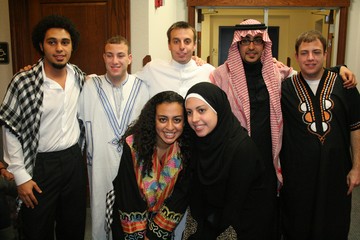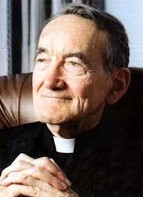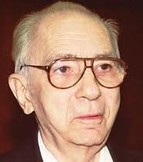Terms: A | B | C | D | E | F | G | H | I | J | K | L | M | N | O | P | Q | R | S | T | U | V | W | X | Y | Z
Terms D
- Delp, Alfred
- De Mello, Anthony
- De Smet, Peter
- Dialogue of Leadership in Jesuit Higher Education, The
- Dialogue Theologically Understood
- Discernment
- Discernment, Ignatian Communal
- Diversity
- Do You Speak Ignatian?
- Docetism
- Doctrinal Congregation
- Downward Mobility
- Dulles, Avery
- Dupuis, Jacques
- Durocher, Marie-Rose
Jesuit Terms D
Delp, Alfred (1907-1945)
German Jesuit; writer and preacher; martyr
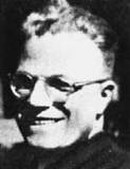 In the early 1940s, people avidly read his regular contributions to the Jesuit review Stimmen der Zeit and came from all over Munich to hear him preach.
In the early 1940s, people avidly read his regular contributions to the Jesuit review Stimmen der Zeit and came from all over Munich to hear him preach.
In 1943, at the invitation of Count von Moltke and with the encouragement of his provincial superior, he joined the secret Kreisau Circle, an anti-Nazi group that was planning a new social order to be built on Christian lines after the War.
The group was found out. Delp was arrested, imprisoned, interrogated, and encouraged to repudiate his Jesuit and Catholic allegiance. But he refused, was "convicted," and was executed on February 2, 1945. The Nazis disposed of his body secretly so that his grave would not become a place of pilgrimage; and so people today visit the parish church where he served.
De Mello, Anthony (1931-1987)
Indian Jesuit; teacher of eastern spiritual practices to the West
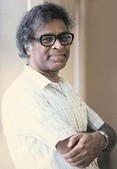 Born in Mumbai (Bombay), India, Anthony De Mello studied psychology at Loyola University Chicago and then set up his spiritual center, "Sadhana Institute," in Pune (Poona), India. In the 1970s, he started offering guided awareness exercises (e.g., attentiveness to one's breathing) to Christians in India and, during summers, in the U.S. He also offered them to his Jesuit brothers at General Congregation 32 (1974-1975). These exercises were finally published as Sadhana: A Way to God—Christian Exercises in Eastern Form (1978). Many more books followed until his sudden death in New York at age 56, and even then, friends and disciples published a number of manuscripts that he was working on. His bibliography totals 59 books. His book Awareness (1992), which transcribes one of his workshops, is said to be a good place to start becoming acquainted with his approach. Several of his workshops are also available in video form.
Born in Mumbai (Bombay), India, Anthony De Mello studied psychology at Loyola University Chicago and then set up his spiritual center, "Sadhana Institute," in Pune (Poona), India. In the 1970s, he started offering guided awareness exercises (e.g., attentiveness to one's breathing) to Christians in India and, during summers, in the U.S. He also offered them to his Jesuit brothers at General Congregation 32 (1974-1975). These exercises were finally published as Sadhana: A Way to God—Christian Exercises in Eastern Form (1978). Many more books followed until his sudden death in New York at age 56, and even then, friends and disciples published a number of manuscripts that he was working on. His bibliography totals 59 books. His book Awareness (1992), which transcribes one of his workshops, is said to be a good place to start becoming acquainted with his approach. Several of his workshops are also available in video form.
In 1998, 11 years after De Mello's death, the Vatican Congregation for the Doctrine of the Faith (under Cardinal Joseph Ratzinger) issued a "Notification" that some of his writings were a danger to the Catholic faith. Even a cursory reading of a page-worth of his sayings, stories, and parables, readily available on the internet, makes clear that De Mello has a certain anti-institutional bias toward religion. His basic message is "spiritual," not "religious." It is a call to awareness, a call to "wake up" from the "sleep" that most people live in without realizing it. In this quest, he is just as apt to turn to non-Christian sources as to Christian ones.
See the De Mello website www.demellospirituality.com
Anthony de Mello: Writings, ed. William V. Dych (Orbis, 1999; Modern Spiritual Masters Series). Dych's introduction to De Mello is outstanding.
De Smet, Peter (1801-1873)
Belgian Jesuit; Promoter of Missions to NW Native Americans
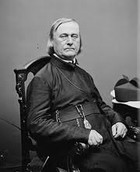 Peter De Smet came to the United States in 1821, entered the Jesuits, and was ordained in 1827. Twelve years later, he encountered two Flathead Indians seeking priests to instruct their nation. This event proved to be the turning point in his life, and he soon became the founder of missions to the Rocky Mountain Northwest Native Americans. He visited the Rocky Mountain area, founded St. Mary's near Missoula, MT, then went to the far Northwest and planned the growth of the church in Oregon country.
Peter De Smet came to the United States in 1821, entered the Jesuits, and was ordained in 1827. Twelve years later, he encountered two Flathead Indians seeking priests to instruct their nation. This event proved to be the turning point in his life, and he soon became the founder of missions to the Rocky Mountain Northwest Native Americans. He visited the Rocky Mountain area, founded St. Mary's near Missoula, MT, then went to the far Northwest and planned the growth of the church in Oregon country.
In 1843 he sailed to Europe and recruited five Jesuits and six Sisters of Notre Dame de Namur for mission work in the Northwest. In the 1850s and 1860s he visited the Plains and the Rocky Mountains seven times as an emissary of the federal government. In 1864 he was the only white man trusted enough to be allowed into Sitting Bull's camp.
De Smet was not so much a missionary as he was a promoter and procurator of missions. In their interest he made repeated journeys to the mountains and crossed the Atlantic sixteen times.
Dialogue of Leadership in Jesuit Higher Education
Howard Gray presentation for the AJCU Seminar on Higher Education Leadership, Loyola University Chicago (2013)
Howard Gray's The Dialogue of Leadership "focuses on dialogue as an essential component in clarifying the Ignatian-Jesuit mission of our schools and on fostering dialogue as one of the major responsbilities of administration in a Jesuit college or university."
The concept of dialogue comes from the work of Austrian-born Jewish religious philosopher Martin Buber (1878-1965), who spent much of his early life in Germany and later life in Israel. For Buber, dialogue was always the establishing of a relationship in which people turn to one another truthfully not simply to learn something but to become someone through mutual acceptance. Dialogue "was not a ploy, not a technique, but the surface expression of the core values of honesty, curiosity, and humility" (John O'Malley).
Pope Paul VI, with his first encyclical Ecclesiam Suam (1963), introduced the term dialogue into the language of the Catholic Church, applying it to relationships within the church (including with all Christians) and to relationships with believers outside the church and even to non-believers. Shortly, it became a key term at Vatican II, appearing in its documents some 70 times.
From a Jesuit perspective, dialogue resonates with the Ignatian human and spiritual developmental paradigm of attentiveness and reverence (appreciation) leading to devotion (consolation). At the same time it helps one to recognize the opposite pattern of the structures of evil that hide, distort, or disfigure the way of God, oppressing people and truncating their growth. Hence the Jesuit determination to live a faith that does justice. A leader of Jesuit education, then, needs to foster at every level encounters with reality, modeling and creating an atmosphere for attention, reverence, and devotion to occur and thrive. (And do this, of course, not through imposition but though evoking the free response of unique individuals.) For example, then, helping colleagues (or students) to engage with the poor and marginal of our culture in a way that does not reinforce stereotypes about them but involves practicing the dialogic qualities of mutuality, truthfulness, the humility to listen and to learn, a growth in relationship.
The concluding testimony from a secular academic shows how dialogic leaders give voice to their feelings about what is important in their lives and connect that to the interests of others. (Recall the quality of the personal sharing at Joe Appleyard's "Cohasset Weekends" [Boston College] and George Traub's "Grailville Weekends" [Xavier U.] in the 1980s and 90s.) The Ignatian leader inspires others to be part of the community of ongoing dialogue.
Buber, I and Thou (1923, English trans. 1937) and Between Man and Man (1948)
"Finding God in All Things" in "Jesuit A to Z," below
Gray, "Soul Education" in A Jesuit Education Reader (2008)
Jesuit Conference, "Communal Reflection on the Jesuit Mission in Higher Education: A Way of Proceeding" (2002),
in A Jesuit Education Reader
"Some Characteristics of Jesuit Colleges and Universities: A Self-Evaluation Instrument" (2012)
Appleyard, "The Languages We Use," Studies in the Spirituality of Jesuits (March 1987)
Dialogue Theologically Understood
From Jesuit General Congregation 34 (1995)
"One way of serving God's mystery of salvation is through dialogue, a spiritual conversation of equal partners, that opens human beings to the core of their identity. In such a dialogue, we come into contact with the activity of God in the lives of other men and women, and deepen our sense of this divine action: "By dialogue, we let God be present in our midst; for as we open ourselves in dialogue to one another, we also open ourselves to God." We try to enable people to become aware of God's presence in their culture and to help them evangelize others in their turn. The ministry of dialogue is conducted with a sense that God's action is antecedent to ours. We do not plant the seed of his presence, for he has already done that in the culture; he is already bringing it to fruitfulness, embracing all the diversity of creation, and our role is to cooperate with this divine activity."
GC 34, Decree 4: #17
Discernment
Ignatius of Loyola called the process "discernment of spirits," but in the language of today we might call it "sifting our moods and feelings" or "learning to read the body's signals" (Gerard W. Hughes). It can be a great help for making choices, in a context of (Christian) faith, when the option is between several courses of action, all of which seem good. It involves prayer, reflection, and consultation—all with honest attention not only to the rational (reasons pro and con) but also to the realm of one's feelings, emotions, and desires.
A basic question then becomes "Where is this impulse from—the good spirit (of God) or the evil spirit (leading one away from God)." In the case of a person leading a fundamentally good life, Ignatius teaches, the good spirit gives "consolation"—acts quietly, gently and leads one to peace, joy and deeds of loving service—while the bad spirit brings "desolation"—agitates, disturbs the peace, and injects fears and discouragement to keep one from doing good.
Discernment, Ignatian Communal
A spiritual approach to group decision-making, simply summarized in eight steps:
1. Outline the pros and cons of the decision with respect to the our mission, vision, and values.
2. Approach deliberations with an impartial mindset (Ignatian indifference).
3. Share my opinions.
4. Encourage and support the contributions of others.
5. Give close attention to the viewpoints of others'—more so if disagreements arise.
6. Be mindful of feelings of unease or agitation (Ignatian desolation).
7. Notice God's presence and will.
8. Deliberate until we have a shared sense of contentment with a decision (Ignatian consolation).
By Debra Mooney, PhD
See Leadership in the Ignatian Tradition: Personal and Communal Discernment and
An Ignatian Prayer for Decision-Making Meetings
Back to top
Diversity
Jesuit schools are respected for academic excellence, the promotion of social justice, and "finding God in all things." These mission-driven values, as well as the necessity to prepare students for a rapidly changing multicultural and global society, draw Jesuit educational institutions to lead in the call for diversity and the inclusion of all peoples. A respect for all human persons and differences is a significant aspect of the history of the Society of Jesus. Ignatius Loyola befriended fellow students who were quite different from himself with regard to social class, age, and nationality, rather unique in the 1500s; they became the founding companions. In 1995, the Society addressed relationships with non-Catholics and women—see General Congregation 34.
Do You Speak Ignatian?
This "Glossary of Ignatian and Jesuit Terms" by George Traub, SJ, of Xavier's Center for Mission and Identity, was not his idea. Both the idea and the title came from Bill Daily (Communication Arts) and Jo Ann Recker, SNDdeN (Modern Languages). Chris Potter (Campus Ministry) designed the original cover and by giving away copies at Heartland II (1997 in St. Louis) made it known beyond Xavier. Since the 12th edition (2010), the cover is graced with a portrait of Ignatius by Cincinnati artist Holly Schapker (XU 1992) from her collection ADSUM: Contemporary Paintings on Ignatian Spirituality.
The booklet reached a milestone in 2017 with 100,000 copies in print, and the 20th Anniversary Edition (2017) had significant revisions and ten new entries.
Docetism
From the Greek dokeo meaning "to appear."
The early Christian heresy (condemened by the Council of Nicaea in 325) that Jesus was not really fully human, but only appeared to be so. His body was not real and therefore he could not and did not suffer. He was God, as it were acting out a play with a pre-determined script and so with full foreknowledge of everything that was going to happen to him, unlike real human beings who have to act with limited knowledge of the future.
The 20th-century Jesuit theologian Karl Rahner (1904-1984) frequently called attention to the fact that many ordinary Christian believers were implicitly and unwittingly docetist in that they thought and talked about Jesus' divinity in a way that cancelled out his humanity, whereas orthodox Christian doctrine does not "mix" his two natures. How they can both be present (technically called the "hypostatic union") is a mystery beyond human ability to understand.
Rahner offers some possible understanding of Jesus' human self-knowledge as "separate" from his divine knowledge and not directly influenced by it. So, to the question did the human Jesus know he was God, Rahner answers "No" and "Yes." The human Jesus himself would have answered "No" in the sense that a Jew of his time knew there was only one God and, as the gospels testify, he had an intimate relationship with the One he called and prayed to as Abba ("Father," "Dad"). But "Yes" in his "non-thematic" awareness—the kind we humans have of ourselves that can't be put into words and concepts and images.
Doctrinal Congregation
Doctrinal Congregation (short for Congregation for the Doctrine of the Faith)—the Vatican office that deals with orthodoxy and dissent. Other Christian bodies have less organized ways of dealing with the issue.
Because what the church preaches and teaches matters, this is a perennial concern. It appears in the early centuries once Jewish Christianity moved out into the Greek and Roman world.
The existence of some such agency as the Doctrinal Congregation is not the real issue. Rather it is the way in which the congregation conducts its business. Is there respect for the human and Christian dignity of anyone accused or does the investigative body operate like a totalitarian power which has no limits because none are built into it?
For a fuller picture of the history involved.
See "
Back to top
Downward Mobility
A term coined by the late Dean Brackley as part of his contemporary reading of Ignatius' Meditation on Two Standards.
Mainstream contemporary culture offers individualistic "upward mobility" as the goal of life. It plays on our human sense of insecurity and fear which with September 11, 2001, became globalized: "a sensation of physical insecurity has now spread to people who once felt safe." While "upward mobility" is not in itself bad, it often carries with it a host of satellite features that must be considered dangerous.
Thus Ignatius presents us with the way of Lucifer/Satan. According to Brackley's contemporary reading, it is characterized by covetousness, status symbols, the social ladder, arrogant pride, the outcast, and the paragon, competition, the pyramid, mistrust and coercion, cover-up.
In contrast to this way of Lucifer/Satan, the way of Christ is "downward mobility." It is characterized by faith, indifference to honors, recognizing others' humanity/sharing, humility as solidarity, a community of equals, and cooperation. In short ...
- Communities of "new human beings" and human relations must exercise prophetic witness to unmask the great cover-up. They must be places from which to work for a more hospitable world—for a society where ... "it is easier for people to be good."
[The preceding is an abbreviated version; to read the whole essay]
Dulles, Avery (1918-2008)
American Jesuit; theologian of "models"; cardinal
Avery Dulles's father, John Foster Dulles, was U.S. Secretary of State in the Eisenhower Administration (1952-1960). Avery, though brought up in his family's Presbyterian Christianity, considered himself an agnostic when he entered Harvard as an undergraduate in 1936. By the time of his graduation, however, he had become a Catholic, something not easy for his parents to accept in that pre-ecumenical era (A Testimonial to Grace [1946]).
After service in the military during World War II, he entered the Jesuits in 1946 at the age of 28. He did doctoral studies in theology at the Jesuit Gregorian University in Rome and then taught for many years at Woodstock College, the Jesuit theological school in rural Maryland. Later, he joined the faculty at Catholic University in DC, and finally, he was McGinley Professor at Fordham in NYC.
Among his published works—25 books and more than 800 articles, many of them translated into other languages—perhaps the most significant are his "models," books where he lined up the various theological opinions on a given subject in relation to one another and assessed the strengths and weaknesses of each: Models of the Church (1974 and subsequent editions), Models of Revelation (1983, 1992), and The Assurance of Things Hoped For: A Theology of Christian Faith (1994). He had a deep knowledge of the long and diverse tradition, could write about it with clarity and so help foster a unity of faith in a post-Vatican II Catholic culture that he saw as increasingly unmoored. It was his contention that the truth lies, not in any one position, but in the totality of them all.
Pope John Paul II made Dulles a cardinal in 2001. Many "liberal" Catholics saw this as a benediction on Dulles' supposed move to the right (for example, he was adamantly opposed to the ordination of women), but others read it more generally as a recognition that American Catholic theology had come of age (Dulles was the first American theologian to be given a red hat).
Dupuis, Jacques (1923-2004)
Belgian Jesuit; theologian of religious pluralism
Jacques Dupuis went to teach in India in 1949, and his more than 30 years there, where Christianity is such a tiny part of the predominantly Hindu culture, had a profound impact on his theology.
In 1984 he left India and started teaching systematic theology and "other religions" at the Jesuit-sponsored Gregorian University in Rome. In 1997 he published a book, Toward a Christian Theology of Religious Pluralism (Orbis), articulating an "inclusive pluralism" that seeks to hold together the constitutive and universal character of the Christ-event in the order of human salvation and the salvific significance of [other] religious traditions . . . within the one manifold plan of God for humankind. The book drew a Vatican investigation of its orthodoxy. First, without explanation, Dupuis was removed from his teaching post. Then, in 2001, the Doctrinal Congregation headed by Josef Ratzinger issued a "notification" (or "warning") that the book contained, grave errors . . . and ambiguities (unspecified). Jesuit superior general Peter-Hans Kolvenbach responded with a public statement encouraging Dupuis to continue his pioneering work in interreligious dialogue. Sadly, however, his arbitrary treatment by the Congregation plunged him into severe depression, and this along with other illness led to his death a few years later.
See Mary Ann Hinsdale, "Jesuit Theological Discourse since Vatican II," Cambridge Companion to the Jesuits, ed. Thomas Worcester (2008).
Durocher, Marie-Rose (1811-1849)
Founder of the Sisters of the Holy Names of Jesus and Mary
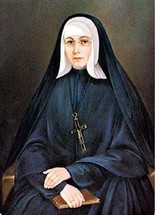 Eulalie Durocher was born in a small town along the Richelieu River in Quebec on October 6, 1811. From 1831 to 1843 she served as the housekeeper at the rectory in Beloeil, Quebec, where her brother was the parish priest. During these years, Eulalie saw the great need for youth education in the small farming community where she lived. Girls in particular received little schooling, and although Eulalie had little formal education herself, she was determined to do something to change the situation for girls in rural Quebec.
Eulalie Durocher was born in a small town along the Richelieu River in Quebec on October 6, 1811. From 1831 to 1843 she served as the housekeeper at the rectory in Beloeil, Quebec, where her brother was the parish priest. During these years, Eulalie saw the great need for youth education in the small farming community where she lived. Girls in particular received little schooling, and although Eulalie had little formal education herself, she was determined to do something to change the situation for girls in rural Quebec.
Eulalie felt a calling to religious life and felt that she could best educate children as a religious, but poor health prevented her from entering several times. In 1843, at the request of Bishop Ignace Bourget, Eulalie went to Longueuil, outside of Montreal, to found a new teaching community with two other women. Patterned on a French community of the same name, this new community was known as the Sisters of the Holy Names of Jesus and Mary.
Eulalie was given the religious name Marie-Rose and was selected by the bishop as the community's first superior. Mother Marie-Rose oversaw her fledgling community for only six years before dying at age 38 on October 6, 1849. By her faith, her judgment, and her apostolic creativity, Mother Marie-Rose had a great influence on the society and the church of Quebec. A born educator, she knew how to develop people's gifts and how to open her congregation to the future.
Mother Marie-Rose was beatified in Rome by Pope John Paul II on May 23, 1982. Her remains are at the Co-cathedral of St. Anthony of Padua in Longueuil.
Today, the congregation consists of some 1,000 sisters and 600 associates living and ministering in Canada, the United States, Lesotho, Peru, and Brazil. Inspired by the zeal of Blessed Marie-Rose Durocher, in collaboration with multiple ministry partners, the sisters respond to contemporary needs through formal education in K-12 and university, pastoral, and social service settings. Sisters and their associates remain dedicated to educational works which promote the full development of the human person, with special concern for those marginalized by society. The U.S.-Ontario Province of the Sisters of the Holy Names is responsible for six high schools on the east and west coasts; Holy Names University in Oakland, California; community learning centers; and a medical clinic in Tutwiler, Mississippi. In collaboration with Jesuit peers, several SNJM theologians have been instrumental in making the Spiritual Exercises of St. Ignatius accessible to women in North America and in Africa.
JESUIT A TO Z: An expanded version of the publication "Do You Speak Ignatian?"

